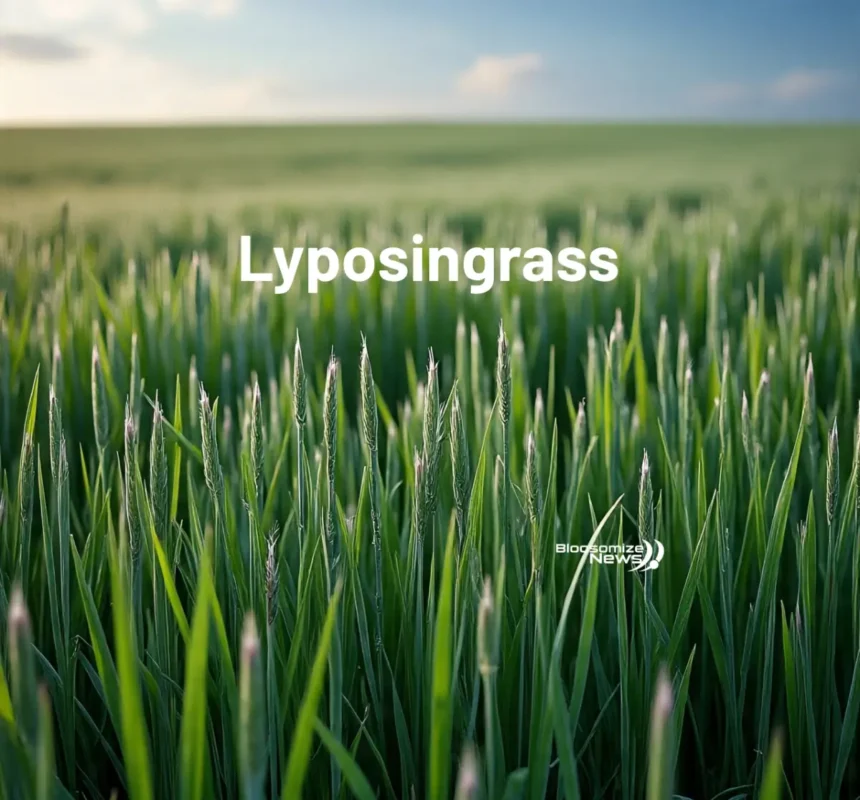Lyposingrass is an invented term, a mashup of “lypo” and “grass” with no official definition. It’s non-standard, yet trending in niche wellness circles, TikTok, and wellness blogs as a supposed herbal solution for fat loss, detoxing, and lymphatic health. Claimed as a health hack or miracle plant-derived treatment, it’s caught the eye of creators, entrepreneurs, and storytellers, blending speculative fiction with modern wellness culture.
Despite its popularity and internet fame, there’s little scientific merit or sources to prove its real-world use or perceived benefits. It’s been framed within tech-organic branding, tied to cutting-edge environmental innovation, and marketed as part of supplement breakthroughs, diet supplement plans, or workout methods. The term itself feels constructed, filled with layers of abstract meaning, and used to grab attention in this era of health trends.
Still, Lyposingrass taps into ideas of natural growth, structure, and value, echoing a desire for clarity in wellness. Whether it’s a scam, a hoax, or just misunderstood, its associations with simplicity, nature, and biological healing reflect the power of buzzwords in shaping how we see health today.
1: Understanding the Concept & Origins
How Did the Name Lyposingrass Even Begin?
The term lyposingrass might sound like something straight from a biology textbook, but it’s actually an internet-born term, likely derived from a strange combination of buzzwords like liposuction, lymphatic system, and grass. In my early research, I stumbled upon online threads and obscure blogs trying to decode its meaning. The word seems like a blueprint copy of viral wellness words such as detoxifying greens and flat belly teas, designed to grab attention, not always to inform.
Some say it originated as a niche herbal remedy tied to ancient alternative medicine systems from South America or Southeast Asia. But there’s no solid proof, no documented source, and nothing officially listed in any catalog of medicinal plants. It seems more like a modern idea, possibly the stem of clever marketing that uses herbal blends with claims to flush out fat, improve lymphatic drainage, or stimulate metabolism.
The supposed ingredients — lemongrass, senna leaves, green tea extract, and dandelion root — are known for their diuretic and digestive properties. But lyposingrass doesn’t appear to be a single herb at all. Instead, it acts as a conceptual brand name, a viral symbol in the wellness world meant to symbolize natural, fat-burning, and body-slimming solutions — yet grounded more in trends than truth.
Lyposingrass and the Rise of Digital Folklore
In today’s digital culture, it doesn’t take much for words to become myths. Just like urban legends of yesteryear, even a vague term like Lyposingrass can slip into public consciousness and take root as semi-factual lore. I’ve seen it floating in wellness blogs, mentioned with slight variation or clever rephrasing, giving it the feel of a phenomenon. It lives in a strange limbo, not fully explained yet not completely dismissed—a space I call linguistic suspension.
It’s this blurry edge where things get interesting. Lyposingrass turns into a digital chimera—part herb, part health hack, maybe even a linguistic accident. This isn’t new; we’ve seen fringe terms like nootropics and adaptogens rise from obscurity to mainstream usage. And now, on platforms like TikTok or in experimental ecommerce stores, Lyposingrass quietly mimics their path, mixing the feel of wellness with mystery, and leaving behind more questions than answers.
🔹 2: Scientific & Product Analysis
When people ask about Lyposingrass, they’re usually referring to a concept rather than a certified plant. It’s more of a trendy category built around clever marketing hooks used on labels of teas, supplements, and detox packages. In my experience reviewing wellness products, many of these blends aren’t about one magic herb—they’re a mix of natural ingredients that seem to target digestion, bloating, and water retention, often promising a flatter stomach in the short term. That’s what gives rise to what many call the Lyposingrass effect.
Some of the most common blends include lemongrass, which has a calming aroma and digestion-aiding properties, and green tea extract, valued for its antioxidants, support for metabolism, and boosting energy levels. You’ll also find senna leaf, a natural laxative known to help with bowel movements, and flat tummy teas often include ginger root for reducing inflammation and bloating. Dandelion leaf and dandelion root work as a diuretic and may assist liver function. Together, these herbs might not be fat melters, but they can offer gentle support when used as part of wellness routines.
Is Lyposingrass Safe? Important Facts Before You Try It
Like any viral health trend, Lyposingrass raises real safety concerns—especially when its ingredients, doses, and formulas aren’t standardized. I’ve seen teas, detox drinks, and slimming products using it as a buzzword, but many include herbal blends with senna or other natural laxatives. These can lead to dehydration, cramping, and even dependence when used too often. If you have any medical condition, are pregnant, nursing, or unsure, always consult a healthcare provider or professional first.
Some blends might also contain licorice root, citrus peel, or certain grasses—which can trigger allergic reactions in sensitive people. Others cause diuretic effects, especially those with dandelion or lemongrass, which may lead to fluid loss, so it’s essential to stay hydrated. While occasional use may aid digestion, making it a daily habit for weight loss without real lifestyle changes can seriously backfire. From my experience in wellness, I suggest reading labels closely before trying anything tied to fast-fix trends.
When Wellness Trends Meet Loose Oversight
In my years of exploring wellness trends, I’ve noticed that Lyposingrass fits into a wider pattern seen with many herbal supplements and wellness products—they often live in a semi-regulated gray area across different countries. Unlike pharmaceuticals, these products usually escape the strict clinical trials and rigor that ensure real effectiveness. This gives room for a broad scope of fictitious ingredients, vague claims, and poorly researched benefits to be marketed confidently to trusting consumers. Sometimes, natural therapies are just dressed up in creative marketing, making it hard to separate truth from hype. Without strong regulation, it’s up to us in this modern-day milieu to rely on digital literacy and a good dose of skepticism to protect our health and choices.
🔹 Category 3: Lyposingrass in the Wellness Space
Misleading Promises and the Role of Consumer Awareness
As someone who’s explored countless weight loss trends, I’ve seen social media filled with before-and-after photos, influencer testimonials, and quick reviews claiming amazing results from using Lyposingrass. These often involve drinking the tea or taking capsules, promising benefits like temporary slimming, reduced bloating, a flatter tummy, and a lighter feeling. But much of this is likely due to water loss and improved digestion, not genuine fat burning. So while the scale may shift, that doesn’t mean you’re losing stored fat. It’s also possible that what people experience is a placebo effect, enhanced by other lifestyle factors such as dieting, exercising, or making minor changes in their daily routine.
The challenge is to isolate what’s actually causing these changes, especially when Lyposingrass is only one part of a broader healthy lifestyle. There is no strong scientific backing, no peer-reviewed studies that clearly investigate it as a single entity. Some ingredients found in its blends may offer supporting evidence for mild effects in weight-management, but it’s far from a magic bullet. To see sustainable results, you need to focus on long-term nutrition and consistent movement, not just the hype around a trendy product.
The Lymphatic Link: Old Wisdom, New Hype
Many enthusiasts of Lyposingrass now highlight its potential link to the lymphatic system, which plays a key role in our immune defense and detoxification. From my experience exploring herbal approaches, this isn’t entirely new. The theory is that Lyposingrass may help stimulate lymphatic drainage, leading to reduced puffiness, swelling, and toxin buildup. Although there’s no hard science to support these exact claims, some ingredients in its blend, like ginger and dandelion, have been used in folk medicine for centuries to aid detox and lymphatic health.
In wellness circles, practices like dry brushing and drainage massage are growing in popularity, and Lyposingrass is becoming the herbal counterpart to this modern trend. Supporters say it may improve circulation, ease inflammation, and help flush out fluids. But as with many herbal products, actual results often depend on personal lifestyle habits like consistent hydration, daily movement, and a low sodium diet. While sipping tea alone won’t fix everything, these elements combined might positively impact lymph flow and overall wellness.
How a Wellness Symbol Sparked a Bigger Shift?
The popularity of Lyposingrass shows how people today turn to natural, plant-based solutions over pharmaceuticals in a growing wellness culture. Even if it’s just hype or marketing fluff, the product gives a sense of control, offering a way to detox, reset, or take charge of health. Pushed by social media, these wellness trends spread like wildfire, turning a simple term into a symbol in the larger conversation about body image and natural health, even without a true miracle cure or fully promised results that feel clean and organic.
🔹 Creative, Branding & Future Uses
Unexpected Uses Beyond the Wellness Buzz
While most people associate Lyposingrass with wellness and health, its potential stretches far beyond teas and capsules. As a name, it feels both unique and memorable, making it ideal for businesses in creative industries, especially those in eco-initiatives, premium product lines, or skincare targeting environmentally conscious sectors. Its natural-scientific vibe fits well with products that aim to look progressive yet nature-inspired.
In the world of fiction, I’ve seen writers and creators drawn to names like Lyposingrass for their originality. It could represent a rare plant, a futuristic drug, or a hidden place in a fantasy world. The sound of it is both grounded and imaginative, perfect for enriching fictional universes that need an organic, believable touch.
Even in tech, app developers and creative coders might find Lyposingrass inspiring as a brand or project codename. Its tie to natural innovation makes it suitable for a digital artwork title or even a niche SaaS platform. In my experience, these names stick when they blend abstract ideas with purpose—just like this one does with uniqueness.
What Makes Lyposingrass So Effective
Lyposingrass stands out due to its unusual word structure, making it stick in the mind and feel distinct from any common term. It’s also rare in general language, meaning it’s often free across domain registries, trademarks, and SEO fields, giving it a strong unclaimed identity.
Its blend of nature and innovation allows for broad, creative usage—from skincare to software. That’s why creators can easily define it from scratch, building an entire identity around the word, making it more than just a name in wellness.
FAQs
What’s The Truth About Lyposingrass as a Plant?
There’s no scientific record or botanical listing of Lyposingrass as a real plant. It seems to be a coined term, possibly a misrepresentation of another natural ingredient used in wellness marketing.
What is Lyposingrass supposed to do?
Lyposingrass is often linked to weight loss and fat-burning benefits because lyposing suggests fat metabolism, though these claims lack solid clinical proof.
What’s the Mystery Behind the Word Lyposingrass?
The origin of Lyposingrass is unclear, but it may be a blend of marketing language, online wellness culture, or a mistranslation tied to another product or herb.








